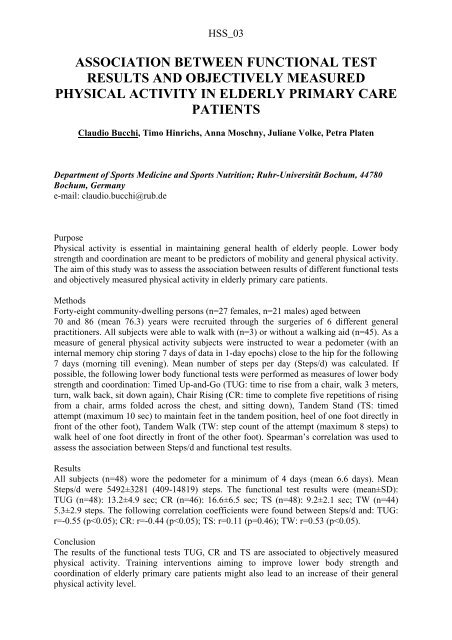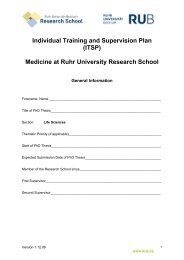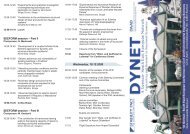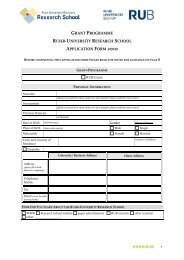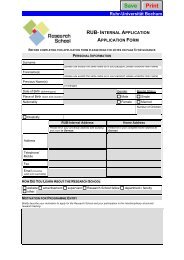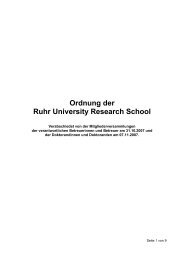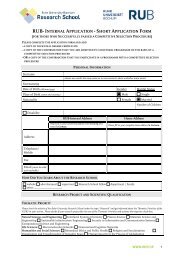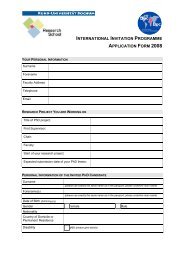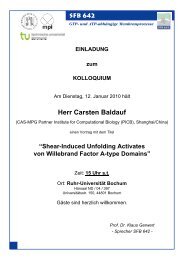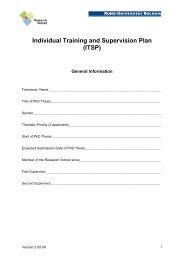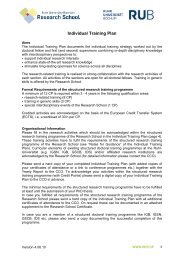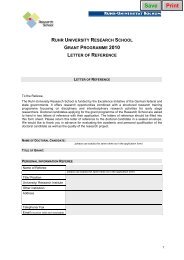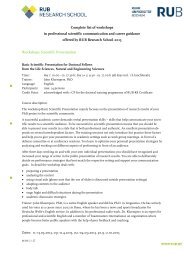Section Days abstract book 2010.indd - RUB Research School ...
Section Days abstract book 2010.indd - RUB Research School ...
Section Days abstract book 2010.indd - RUB Research School ...
Create successful ePaper yourself
Turn your PDF publications into a flip-book with our unique Google optimized e-Paper software.
HSS_03<br />
ASSOCIATION BETWEEN FUNCTIONAL TEST<br />
RESULTS AND OBJECTIVELY MEASURED<br />
PHYSICAL ACTIVITY IN ELDERLY PRIMARY CARE<br />
PATIENTS<br />
Claudio Bucchi, Timo Hinrichs, Anna Moschny, Juliane Volke, Petra Platen<br />
Department of Sports Medicine and Sports Nutrition; Ruhr-Universität Bochum, 44780<br />
Bochum, Germany<br />
e-mail: claudio.bucchi@rub.de<br />
Purpose<br />
Physical activity is essential in maintaining general health of elderly people. Lower body<br />
strength and coordination are meant to be predictors of mobility and general physical activity.<br />
The aim of this study was to assess the association between results of different functional tests<br />
and objectively measured physical activity in elderly primary care patients.<br />
Methods<br />
Forty-eight community-dwelling persons (n=27 females, n=21 males) aged between<br />
70 and 86 (mean 76.3) years were recruited through the surgeries of 6 different general<br />
practitioners. All subjects were able to walk with (n=3) or without a walking aid (n=45). As a<br />
measure of general physical activity subjects were instructed to wear a pedometer (with an<br />
internal memory chip storing 7 days of data in 1-day epochs) close to the hip for the following<br />
7 days (morning till evening). Mean number of steps per day (Steps/d) was calculated. If<br />
possible, the following lower body functional tests were performed as measures of lower body<br />
strength and coordination: Timed Up-and-Go (TUG: time to rise from a chair, walk 3 meters,<br />
turn, walk back, sit down again), Chair Rising (CR: time to complete five repetitions of rising<br />
from a chair, arms folded across the chest, and sitting down), Tandem Stand (TS: timed<br />
attempt (maximum 10 sec) to maintain feet in the tandem position, heel of one foot directly in<br />
front of the other foot), Tandem Walk (TW: step count of the attempt (maximum 8 steps) to<br />
walk heel of one foot directly in front of the other foot). Spearman’s correlation was used to<br />
assess the association between Steps/d and functional test results.<br />
Results<br />
All subjects (n=48) wore the pedometer for a minimum of 4 days (mean 6.6 days). Mean<br />
Steps/d were 5492±3281 (409-14819) steps. The functional test results were (mean±SD):<br />
TUG (n=48): 13.2±4.9 sec; CR (n=46): 16.6±6.5 sec; TS (n=48): 9.2±2.1 sec; TW (n=44)<br />
5.3±2.9 steps. The following correlation coefficients were found between Steps/d and: TUG:<br />
r=-0.55 (p


